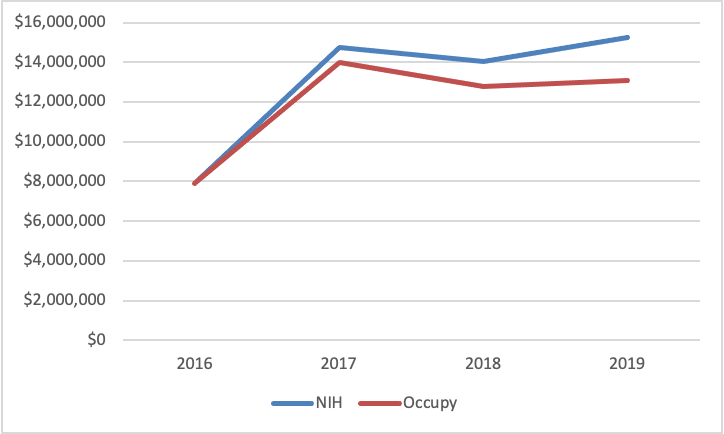
NIH claims to have spent $15 million on ME/CFS research in 2019. However, my examination of the details shows that NIH actually spent $13 million, which means NIH is exaggerating its spending by 14%.
This gap between reality and NIH’s claim distorts the picture of ME/CFS research. While that may make NIH look better, in the long run it helps neither NIH nor the ME community.
Discussions about ME/CFS research funding must start with a solid foundation of facts. We must understand what research is being done, who is doing it, and what resources are being invested. I have been tracking and analyzing the details of the National Institutes of Health’s funding of ME/CFS research since 2012, and it is personally very important to me that I get the details right.
At the end of each federal fiscal year on September 30th, I research and compile a list of all the ME/CFS research projects that received NIH funding that year. However, there is gap in the information available in the fall. NIH does not publish how much intramural (internal) funding was spent on ME/CFS until months later. Once I have this list of what NIH says it spent on ME/CFS, I go back and check all my work and make corrections where needed.
Frequently, I find NIH overstates its funding number. Sometimes NIH includes grants that are not related to ME/CFS research, and sometimes the errors arise from an absence of precise numbers. I’ve examined the additional information on NIH’s 2019 funding, and unfortunately, NIH has once again overstated how much it invested in ME/CFS research by a substantial amount.
The 2019 Fact Check
NIH publishes its total research funding amounts in almost 300 categories on its Categorical Spending page. The chart states that NIH spent $15 million on ME/CFS in 2019. I reviewed the list of all the grants NIH counts towards that $15 million, and found two grants that should not have been included.
First, NIH’s claimed funding to the research centers is not correct. In my previous analysis of the 2019 funding, I reported that NIH had given an administrative supplement award to The Center for Solutions for ME/CFS at Columbia University, but that it was not for ME/CFS research. Dr. Joe Breen from the National Institute of Allergy and Infectious Diseases told me last November that the award funded research into enterovirus D-68, which can cause acute flaccid myelitis in children. The research used technology developed as part of the Center’s ME/CFS research, which is why the supplemental grant went to the Center. Based on Dr. Breen’s explanation, I excluded the amount of this award from my calculations. However, NIH has erroneously included this supplemental award in its Project Listing by Category, which inflates the total funding number by $301,220.
The second discrepancy in NIH’s funding totals is much larger, but not unexpected. As I mentioned above, NIH does not publish its intramural funding numbers until months after the end of the fiscal year. When I published my 2019 funding review, I left a blank for the intramural funding, rather than guess at the amount.
NIH has now published the intramural funding information. The three intramural grants are listed at the bottom of the Project Listing by Category. Two of them, to Dr. Nath and Dr. Saligan, are definitely related to ME/CFS research and the funding amounts are similar to 2018. However, the last project on the list is problematic.
The $2 million grant is called “Pathophysiology of Involuntary Movements and Volitional Disorders” and is led by Dr. Mark Hallett at the National Institute for Neurological Disorders and Stroke. The abstract for the project describes multiple studies on the “pathophysiology of functional (psychogenic) movement disorders (FMD).” ME/CFS is mentioned in the very last sentence of the abstract: “In collaboration with other groups, we are also studying the pathophysiology of mirror movements, ataxia in SCA7, and chronic fatigue syndrome.” Given the scope of the work described in the project abstract–which only mentions ME/CFS once–it is clear that the entire $2 million cannot be fairly counted as ME/CFS research.
This is not the first time NIH has included a huge intramural project that is not focused on ME/CFS. In 2018, the culprit was a $1.5 million grant to study clinical catecholamine neurochemistry. In 2017, the intramural problem was a grant to the Human Energy and Body Weight Regulation Core. Both of these giant grants included work in collaboration with Dr. Avindra Nath’s ME/CFS Clinical Care Center study. However, in both cases, the ME/CFS-related work was a very small sliver of the overall number.
Why does NIH count the entire grant amounts as ME/CFS research when only a small percentage actually qualifies as such? NIH follows an elaborate process to categorize every research project. Each category has a definition and associated terms and concepts. Those terms are assigned weights based on their importance or relevance, and then matched to funded projects. Dr. Hallett’s project abstract specifically mentions “chronic fatigue syndrome,” so it makes sense that it would be a match to the ME/CFS category.
However, the structure of intramural funding presents a unique problem. Labs like Dr. Hallett’s do not receive funds that are earmarked to individual diseases. Nor are the labs required to track and report the way resources were allocated across projects. Instead, the lab receives a total budget and then carries out all its research. As a result, Dr. Hallett’s lab budget is counted in the ME/CFS category, as well as other categories such as “Biomedical Imaging.” The full amount of the budget is counted in both categories because NIH’s system does not require or support allocation of the budget between ME/CFS and biomedical imaging.
This flaw in NIH’s reporting system exaggerates NIH’s funding, and so NIH reports spending much more money on ME/CFS than it actually does. Not only that, there is no way to determine precisely how much was spent on ME/CFS because no one tracks the number. Dr. Hallett is not required to track how much he spent on ME/CFS research versus functional movement disorder research. He can only estimate how much it may have been. Dr. Vicky Whittemore (of NINDS) told me that Dr. Hallett estimates that 5-10% of this grant funding was spent on ME/CFS work related to Dr. Nath’s study.
Dr. Whittemore has been very helpful in answering my questions about the actual amounts spent by the intramural labs in 2018 and 2019. This is a recurring problem, and the overstatement of funding doesn’t help NIH any more than it helps ME advocates. Dr. Whittemore told me, “We are now working with the scientific staff who code the studies for Reporter to confirm what gets added to the ME/CFS numbers.” Hopefully the problem will be solved before NIH reports intramural funding for 2020.
The Correct 2019 Funding Numbers
All that being said, let’s see how this information affects the calculation of NIH’s 2019 funding. I have compensated for the two errors I found in NIH’s list. I excluded the supplemental grant to Dr. Lipkin’s Center ($301,220) from the total Research Center funding. I reduced Dr. Hallett’s grant to 7.5% of his total intramural budget, splitting the difference in his 5-10% estimate. Here is how my calculation compares to NIH’s.
| Spending Type | My Calculation | NIH Calculation |
|---|---|---|
| Extramural | $4,627,302 | $4,627,302 |
| Research Centers | $7,381,515 | $7,682,735 |
| Intramural | $1,088,791 | $2,922,007 |
| Totals | $13,097,608 | $15,232,044 |
The effect of the correction is enormous. NIH’s actual ME/CFS spending was $2.1 million lower than NIH’s claimed funding of $15.2 million, a difference of 14%. There can be no dispute over this. NIH has acknowledged to me that the funding I have excluded from the total was not spent on ME/CFS research.
The overall trend in the exaggerated funding numbers is disturbing as well. The overstated amount has increased every year:

This discrepancy is a really big deal. The numbers on NIH’s Categorical Spending Chart are relied upon by Congress, journalists, and advocates, even when the numbers are actually wrong.
The overstatement of funding makes NIH look better, too. It obscures the truth and minimizes the very serious funding problem in ME/CFS research. Counting money towards ME/CFS that was not actually spent that way, even if it is due to a sloppy accounting policy and not malfeasance, is misleading. Let’s face it, spending $15 million on ME/CFS research sounds much better than spending $13 million.
I wish NIH was spending $15 million. That extra $2 million would fund another research center. It would fund two or three more extramural grants. It’s a huge amount of money in an underfunded disease like ME.
As I stated at the beginning, any discussion about ME/CFS research funding must start with a solid foundation of facts. It is a fact that NIH claims to have spent $15 million on ME/CFS research in 2019. It is a fact that NIH actually spent $13 million on ME/CFS research in 2019. While the higher number casts NIH in a more favorable light, it doesn’t help anyone to rely on faulty data. A recurring problem in the history of ME research is the gap between what the government and advocates perceive to be true. So let’s start with a hard and verifiable number: NIH actually spent $13 million on ME/CFS research in 2019.
Jennie, good for you–nobody else is doing this kind of work, exerting pressure on the NIH to at least come clean about its serious distaste for spending money on us. Meanwhile we can all watch with interest the unfolding story of the relationship between Covid “long haulers” and ME/CFS, and how that will work out in research funding.
Thank goodness for your hard work that helps keep NIH (and other agencies) more accountable!
THANK YOU!
Thank you for doing this important work Jennie, you are a rockstar.
Great work as always, Jennie. Thanks for going over this so carefully so we know how dollars are being spent and what other projects are being listed as ME/CFS.
Thank you for this! As you’ve demonstrated for years, the NIH is always exaggerating funding and even the exaggerated numbers are not enough for ME! We deserve better and we deserve transparency
I love you!
I love you too!
Thank you for tracking these numbers!
Gee, if they had funded ME research decades ago, the lost productivity, wages and taxes of people with ME might have covered the cost of research that would be helping COVID-19 Long-haulers now.
More than covered it, honestly.
Thank you for working on this!
Pingback: Trial By Error: Jennie Spotila’s Annual Review of NIH Funding